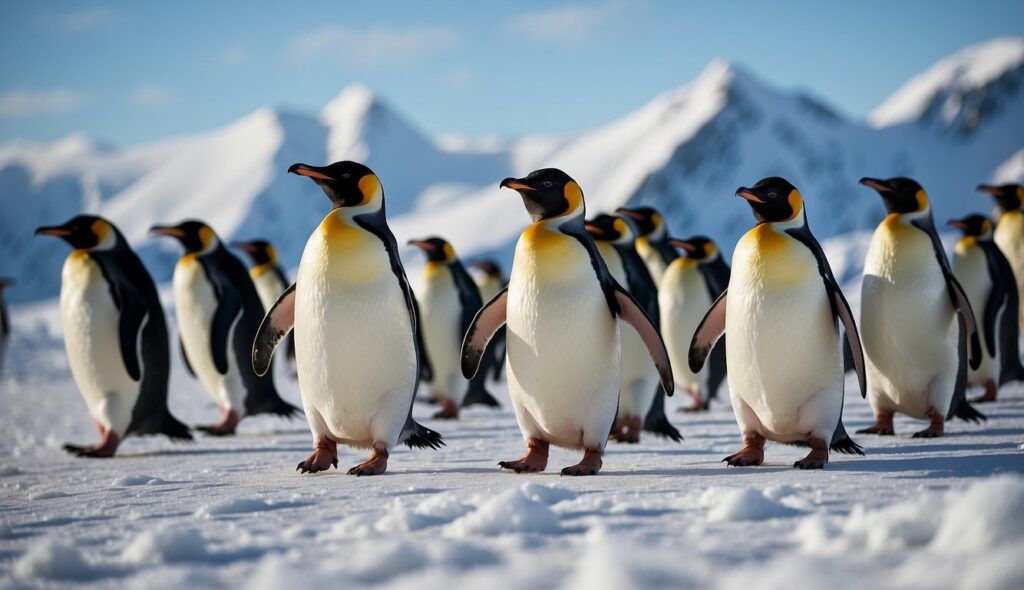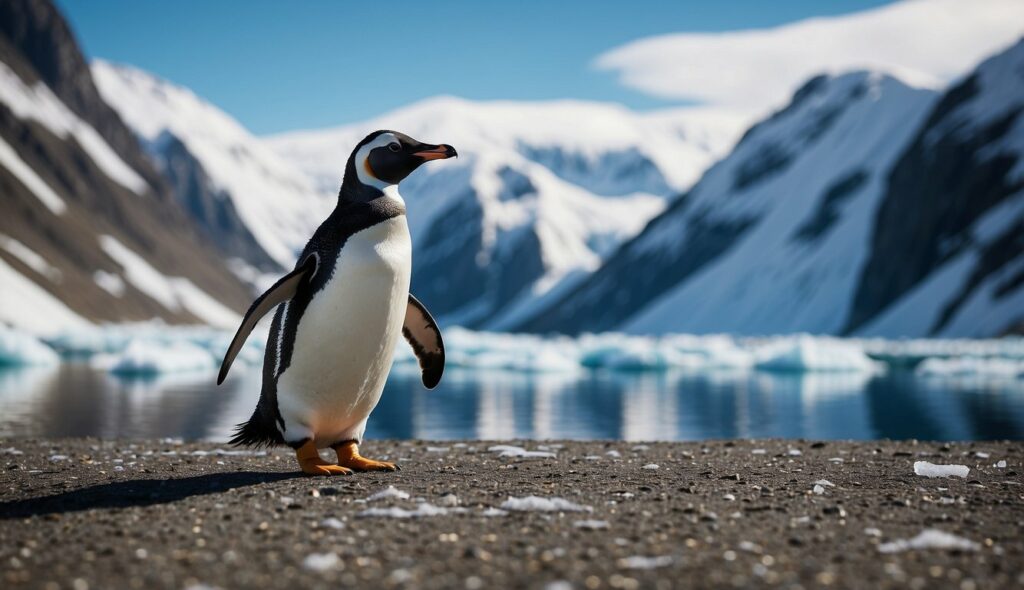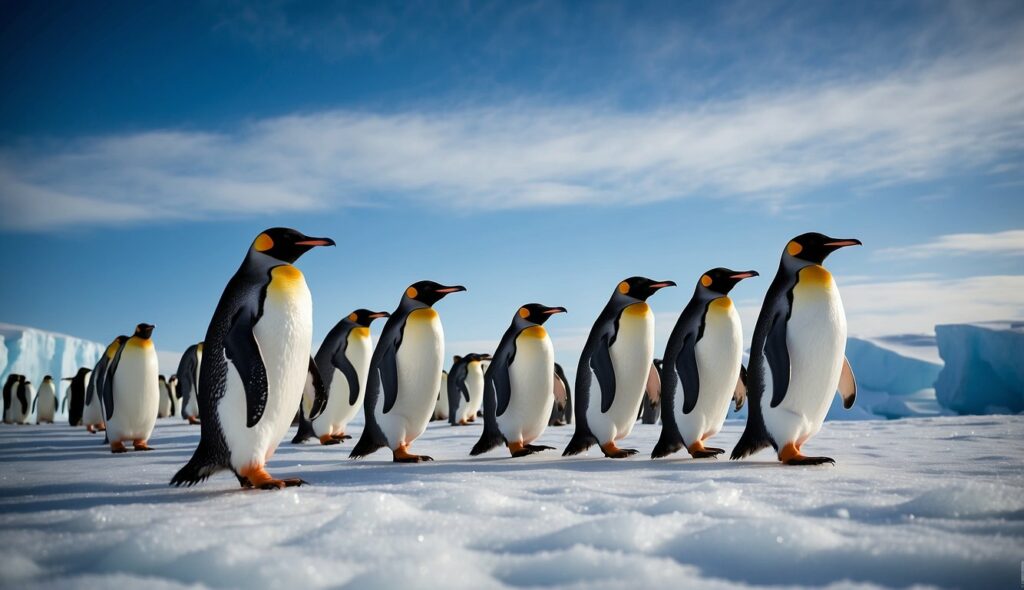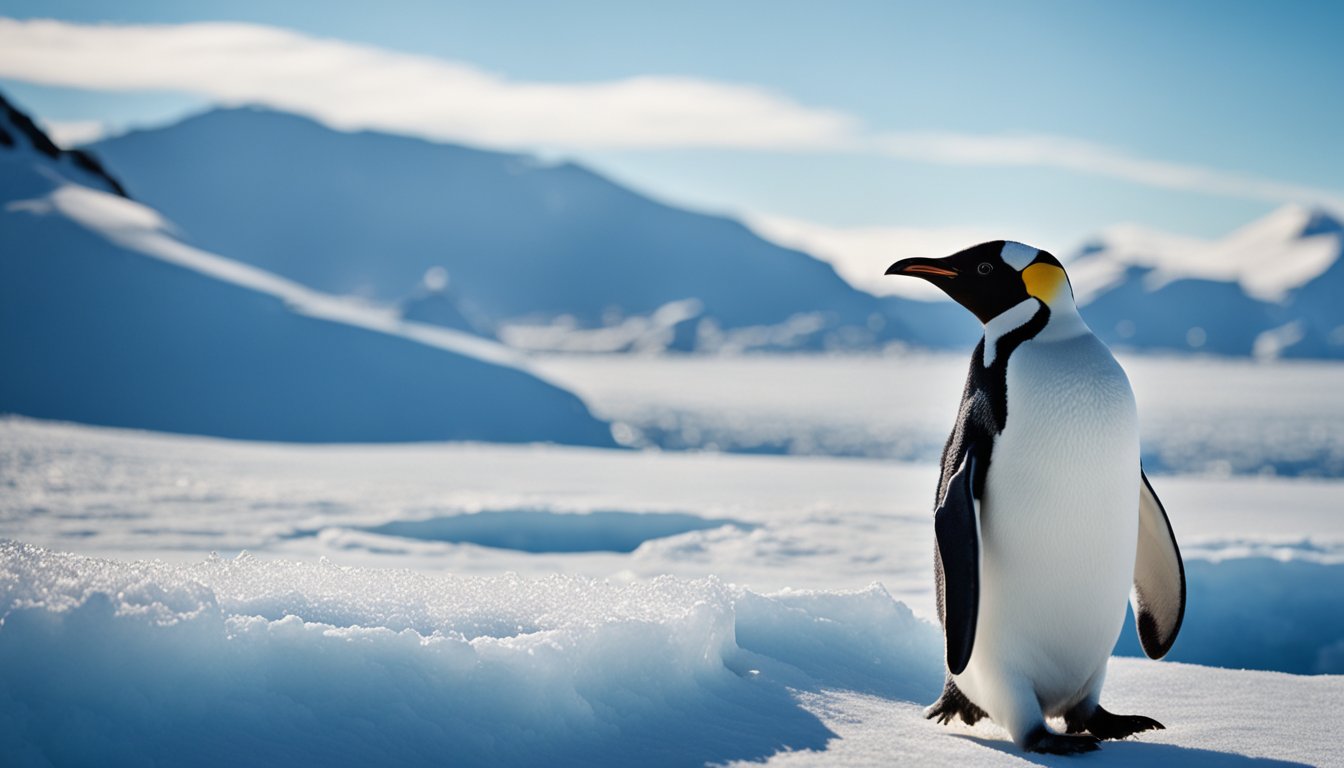Picture a world blanketed in snow and ice, where the sun glimmers off giant icebergs, and the sound of the ocean waves mixes with the call of seabirds.
This is Antarctica, the frozen playground of one of the most charming creatures on the planet – the penguin.
Waddling on their short legs, these birds have captured hearts around the globe with their quirky walk and social behavior.

In the vast and chilly landscapes of Antarctica, penguins have mastered the art of survival.
Their distinctive waddle, a result of their short legs and stout body, is not just a cute quirk; it’s an adaptation that conserves energy as they travel across snowy terrain.
These intrepid explorers brave the coldest environment on Earth, with temperatures that can plummet below minus 50 degrees Celsius!
Have you ever wondered why penguins live where they do and how they spend their days?
It’s fascinating to learn about their lives – from the way they hunt for fish, squid, and krill, dancing through the water with the grace of ballerinas, to the way they care for their fluffy chicks in the harshest conditions.
They nest in large colonies, which buzz with activity and noise, as parents and chicks recognize each other by their distinct calls.
They’re not only survivors. They’re a tight-knit community, demonstrating cooperation and care that humans could learn a great deal from.
The Penguin Parade

Head to the icy shores of Antarctica, and you might be lucky enough to witness one of nature’s most endearing spectacles: the penguin parade!
Did you know that their signature waddle is more than just adorable? It’s a clever adaptation for survival.
Explore why they waddle and meet some of the incredible penguin species that call the Antarctic their home.
Why Penguins Waddle
Imagine wearing a heavy, thick coat all year round and trying to move quickly–it’s not easy, right?
That’s sort of how penguins feel with their dense, waterproof feathers and short, stocky legs. The waddle helps penguins conserve energy.
Each side-to-side motion gives them a little boost, meaning they use less energy to move around.
Plus, their wide stance and short steps keep them stable on slippery ice. They might not win any races, but they expertly navigate their chilly habitat.
Types of Antarctic Penguins
Now, let’s meet some of the stars of the Antarctic penguin parade!
Imagine seeing the black and white of an Emperor penguin standing tall in the icy breeze or a group of sprightly Adelie penguins darting around like tuxedo-clad dancers on the ice.
Emperor Penguins are the largest, with some reaching up to 120 centimeters in height.
They endure the harshest Antarctic winter to raise their chicks.
Then there are the smaller, lively Adelie Penguins, recognizable by the white rings around their eyes.
These are just a couple of the charismatic characters in the diverse array of Antarctic penguins, each with its unique traits and behaviors that bring the icy landscape to life.
Life in The Cold

Penguins are remarkable creatures that have adapted to living in some of the harshest conditions on Earth.
From their diet to the way they raise their young, every aspect of a penguin’s life is shaped by the icy environments they call home.
Penguin Diet and Predators
A penguin’s diet mostly consists of fish, squid, and krill, which they catch with their swift swimming abilities.
Their flippers, streamlined bodies, and keen eyesight make them exceptional hunters in chilly waters.
They usually eat while swimming, snatching up prey with their beaks.
At times, they become prey themselves to predators like the leopard seal and orca whales.
These predators look out for penguins sliding into the water or those swimming alone, turning the hunters into the hunted.
Building Nests and Raising Chicks
Did you know that penguins are diligent when it comes to building their nests and raising their chicks?
They construct nests from stones, pebbles, or whatever materials are available, all to keep their eggs above the wet, freezing ground.
Once the eggs hatch, both parents take turns keeping the chicks warm and fed.
They brave the bitter Antarctic elements, huddling together in large groups for warmth and rotating positions so everyone gets a chance to be shielded from the wind.
Through teamwork and perseverance, they ensure that the next generation of penguins thrives in this cold, unforgiving landscape.
Adaptations for Survival

Imagine living in one of the coldest places on Earth — Antarctica!
Penguins are experts at it, and they have some pretty cool tricks up their, well, flippers to thrive in these icy conditions.
Feathers and Blubber
To stay toasty in sub-zero temperatures, penguins sport a fancy coat of feathers unlike any other bird.
These aren’t just any feathers; they’re super dense, with a fluffy layer underneath that traps warm air close to the body.
It’s like wearing a snug, feathery blanket!
Underneath that, penguins have a thick layer of blubber, which is basically a squishy suit of fat that keeps the chill out and the warmth in.
When they plunge into frigid waters, their feathers waterproof with oils from a special gland, zipping up an invisible wet suit to keep them dry and cozy.
Social Behaviors
Penguins may be champion swimmers, but that’s not the only secret to their survival. They’re also social butterflies of the Antarctic.
They huddle together, creating a feathery fortress to beat the cold. Have you ever seen penguin huddles on TV?
They take turns being on the outside, so everyone gets a turn in the warm center.
And when it comes to looking for food, they’re all about teamwork.
By hunting in groups, they can herd fish together, making it a buffet for everybody.
It sure keeps their bellies full and energy levels high to play in the snow another day!
Frequently Asked Questions

Penguins are fascinating creatures with unique adaptations and behaviors that perfectly suit the icy world they call home.
Ever wonder about the specifics? Get ready to dive into some cool facts!
What are some amazing abilities that penguins have adapted to survive the chilly climate of Antarctica?
Penguins have evolved with several remarkable adaptations to thrive in the frigid Antarctic environment.
Their feathers are highly waterproof and insulating, providing warmth like a cozy winter coat.
Beneath the feathers, a layer of blubber acts as a thermal blanket, keeping these birds comfortable in subzero temperatures.
Moreover, their circulatory system allows them to maintain warmth in vital organs while swimming in icy waters.
These adaptations show nature’s ingenuity and make penguins Antarctic survivalists.
Why do penguins waddle and how does this unique movement help them in their icy habitat?
Penguins waddle for a good reason – it’s an energy-efficient way for them to walk on ice and snow.
Their short legs and bulky bodies mean that a side-to-side motion is more stable than a human stride.
This waddling movement helps them conserve energy while navigating the unforgiving terrain of their habitat.
Plus, when they toboggan, sliding on their bellies propelled by their flippers, they move faster and save precious energy – one of their many clever tricks!
Can you tell me about the different types of penguins found in Antarctica and how they’re different from each other?
Antarctica is home to several penguin species, each with distinct features.
The Emperor penguin is the largest, standing out with its striking yellow and orange neck feathers.
Antarctic species also include the Adelie penguin, recognizable by its classic tuxedo look, and the Chinstrap penguin, named for the narrow black band under its head.
While these species share a homeland, they have different breeding behaviors and diet preferences, making each one unique in its own right.
What is the daily life like for an Antarctic penguin, from their diet to their social behaviors?
The daily life of an Antarctic penguin is a bustling routine of diving for food, socializing, and surviving.
Their diet mainly consists of fish, squid, and krill, with some species diving over 500 meters to hunt!
On land, they are social birds, communicating with distinct calls and participating in communal activities like nesting and caring for their young.
Living in large colonies, they exhibit intricate social relationships and often show behaviors that resemble human interaction.
How do penguin parents care for their chicks in the harsh conditions of the Antarctic?
In the challenging Antarctic climate, penguin parents are impressively dedicated caregivers.
Emperor penguins lay a single egg and balance it on their feet under a warm flap of skin to protect it from the cold.
Both parents take turns braving the stark conditions to feed, with one hunting for food while the other guards the nest.
Once hatched, chicks are often seen huddling together for warmth in a crèche while their parents are at sea – teamwork is key to their survival!
Could you explain why some species of penguins are only found in Antarctica and not in the Arctic?
Penguins are synonymous with Antarctic ice, but none are found in the Arctic. This is due to evolution and ecological niches.
Many millions of years ago, penguins evolved in the Southern Hemisphere and didn’t spread to the Northern Hemisphere.
They filled available niches in the south, where there were no land predators, allowing them to thrive.
In contrast, the Arctic is home to potential predators like polar bears, and the different environment means it isn’t suited to penguins, who’ve specialized for their Antarctic home.









